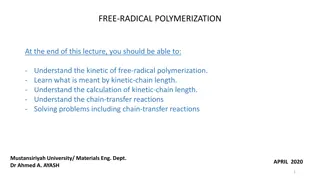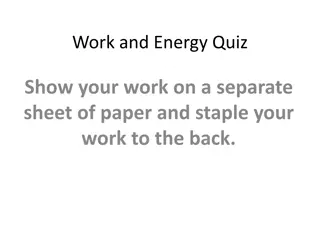Turbulence Kinetic Energy (TKE) Budget Equations Overview
The Turbulence Kinetic Energy (TKE) budget equation explores the different terms contributing to the generation and consumption of turbulence in the atmosphere. It delves into the effects of buoyant production/consumption, mechanical (shear) production, and the importance of Term III in free convection situations. The interplay between these terms helps classify the nature of convection and understand the dynamics of turbulence under various atmospheric conditions.
Download Presentation

Please find below an Image/Link to download the presentation.
The content on the website is provided AS IS for your information and personal use only. It may not be sold, licensed, or shared on other websites without obtaining consent from the author.If you encounter any issues during the download, it is possible that the publisher has removed the file from their server.
You are allowed to download the files provided on this website for personal or commercial use, subject to the condition that they are used lawfully. All files are the property of their respective owners.
The content on the website is provided AS IS for your information and personal use only. It may not be sold, licensed, or shared on other websites without obtaining consent from the author.
E N D
Presentation Transcript
Turbulence kinetic energy (TKE) budget equation Basim ALknani
3- Buoyant Production/Consumption Production Term III is large and positive near the ground, corresponding to a large generation rate of turbulence whenever the underlying surface is warmer than the air. this term represents the effects of thermals in the ML. It's with sunny days overland, or cold air advection over a warmer underlying surface, it can be larger. For cloudy days over land, it can be much smaller. The buoyancy term acts only on the vertical component of TKE. Hence. this production term is anisotropic (not isotropic). In convective boundary layers capped with actively growing cumulus clouds, the positive buoyancy within the cloud can contribute to the production (term Ill) of TKE . consumption : In statically stable conditions, an air parcel displaced vertically by turbulence would experience a buoyancy force pushing it back towards its starting height. Static stability thereby tends to suppress or consume TKE, (negative values of term III), Such conditions are present in the SBL at night over land. or anytime the surface is colder than the overlying air. This same type of consumption can occur at the top of a ML. where warmer air-entrained downward by turbulence opposes the descent because of its buoyancy. This is related to the negative values of the buoyancy term near the top of the ML An example of the decay of turbulence in negatively buoyant conditions just after sunset is shown in the figure.
Term III is so important on days of free convection, it is often used to normalize all the other terms. Dividing (5.1b) by (w* / Zi) gives a dimensionless form of the TKE budget equation that is useful for free convection situations: Equations that are made dimensionless by dividing by scaling parameters are said to be normdized.
4- Mechanical (Shear) Production When there is a turbulent momentum flux in the presence of a mean wind shear. the interaction between the two tends to generate more turbulence. A negative sign precedes Term IV. the momentum flux is usually of opposite sign from the mean shear. resulting in production not loss of turbulence. The greatest wind shear magnitude occurs at the surface (the maximum shear production rate also occurs there). the wind speed frequently varies little with height in the ML above the surface layer. resulting in near zero shear and near zero shear production of turbulence. A smaller maximum of shear production sometimes occurs at the top of the ML because of the wind shear across the entrainment zone. The relative contributions of the buoyancy and shear terms can be used to classify the nature of convection . Free convection scaling is valid when the buoyancy term is much larger than the mechanical term, forced convection scaling is valid when the mechanical term is much larger than the buoyancy term, Magnitudes of the shear production term in the surface layer are obviously greatest on a windy day, and are small on a calm day. In synoptic-scale cyclones the strong winds and overcast skies suggest that forced convection is applicable. At night over land, or anytime the ground is colder than the air, the shear term is often the only term that generates turbulence. Both the buoyant and shear production terms can generate anisotropic turbulence. The difference is that shear generation produces turbulence primarily in the horizontal directions (V and U) components, while buoyant generation produces it primarily in the vertical direction.
Stability Concepts Unstable flows become or remain turbulent. Stable flows become or remain laminar. There are many factors that can cause laminar flow to become turbulent, and other factors that tend to stabilize flows. The static stability is determined by the local lapse rate Static Stability and Convection Static stability is a measure of the capability for buoyant convection. The word "static" means "having no motion"; hence this type of stability does not depend on wind. Air is statically unstable when less-dense air (warmer and/or moister) underlies more dense air. It is better to examine the stability of the whole layer, and make a layer determination of stability ,For example, If at the earth's surface is positive, or if displaced air parcels will rise from the ground or sink from cloud top as thermals traveling across a BL, then the whole BL is said to be unStable or Convective. If is negative at the surface, or if displaced air parcels return to their starting point, then the BL is said to be Stable if the buoyancy term is near zero, then the boundary layer is said to be Neutral. In some of the older literature, the boundary layer of this latter case is also sometimes referred to as an Ekman boundary layer. During fair weather conditions over land, the BL touching the ground is rarely neutral. Neutral conditions are frequently found in the RL aloft. In overcast conditions with strong winds but little temperature difference between the air and the surface, the BL is often close to neutral stability. dynamic Stability The word "dynamic" refers to motion; hence, dynamic stability depends in part on the winds. Even if the air is statically stable, Wind shears may be able to generate turbulence dynamically.
As an example, in the middle 50% of the convective ML the lapse rate is nearly adiabatic, causing an incorrect classification of neutral stability
Q2) What is the static stability of each of the layers in the diagram at right?
Kelvin-Helmholtz (KH) wave is wave begins to "roll up" or "break". This "breaking" wave is called a Kelvin- Helmholtz (KH) wave , These waves are frequent occurrence within statically stable shear layers Clear - Air Turbulence (CAT) These often occur above and below strong wind jets, such as the nocturnal jet and the planetary-scale jet stream. In these situations, continued dynamic forcing's can allow turbulence to continue for hours to days. These regions of CAT have large horizontal extent (hundreds of kilometers in some cases), but usually limited vertical extent (tens to hundred of meters). Home work Q1) From data radio sound, identify the static stability of the air at z = 200 m , 400 m and 1000 m ?
Discussion: This buoyant production term is about an order of magnitude larger than the mechanical production term, meaning that the turbulence is in a state of free convection. In regions of strong turbulence production.























